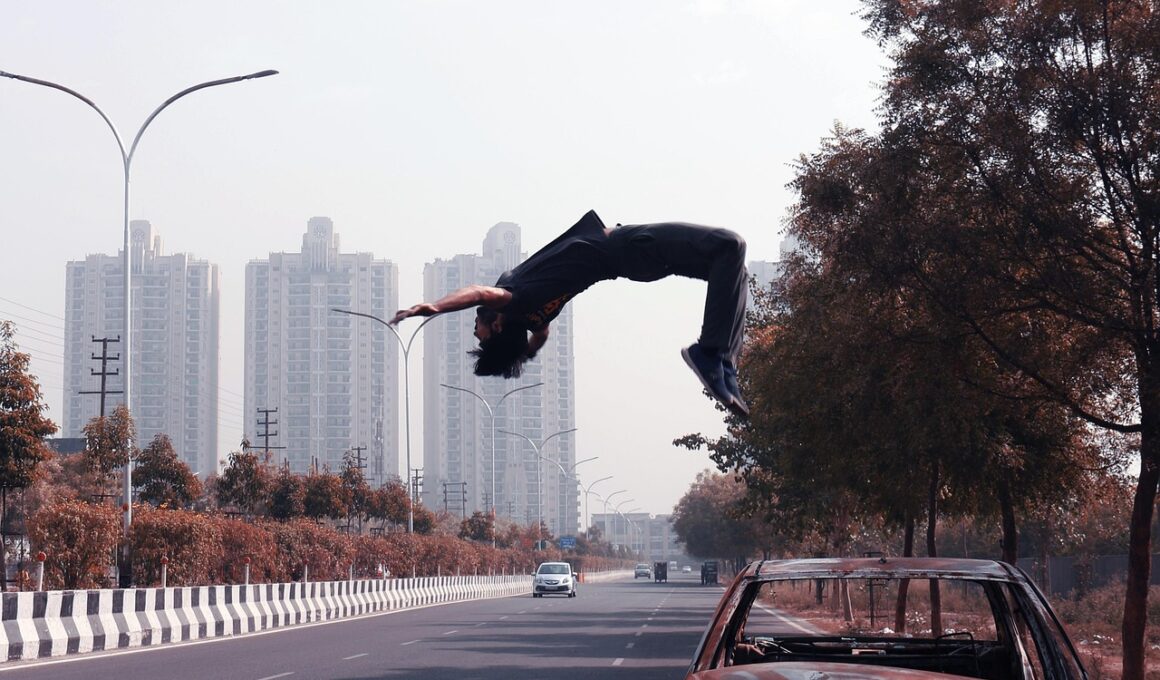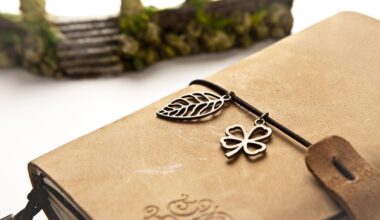How to Layer Clothing Effectively for Outdoor Freerunning
Layering clothing is essential for parkour and freerunning, particularly in outdoor environments. Properly layering your attire can enhance your mobility and comfort during practice or performance, protecting you from unpredictable weather. The foundation of your outfit should include moisture-wicking base layers made from materials like polyester or merino wool. The mid-layers, such as fleeces or light insulated jackets, trap warmth while maintaining breathability. Finally, an outer shell made of windproof or waterproof material can protect against elements such as rain or wind. Each layer must fit well without compromising your range of motion, allowing you to perform stunts freely. Look for stretchy materials that lend support while you engage in dynamic activities. Moreover, choose items with ventilation features, such as mesh panels or zippers, which help dissipate heat during intense training sessions. When investing in parkour apparel, consider quality over quantity to ensure longevity and functionality. Opt for versatile pieces you can mix and match, enabling you to adapt to varying climates and training intensities seamlessly. Ultimately, the right layering strategy will promote better performance and enjoyment while developing your freerunning skills.
Accessories play a crucial role in enhancing your outfit during outdoor parkour sessions. Start with high-performance socks made of moisture-wicking materials to prevent blisters while ensuring your feet stay dry. The choice of shoes is vital, as they must provide support, grip, and durability on various surfaces. Seek out shoes specifically designed for parkour, as they offer flexibility and shock absorption. Additionally, consider wearing a well-fitted beanie or headband to keep sweat away from your eyes, enhancing visibility as you navigate urban obstacles. When choosing gloves, look for lightweight, breathable options that offer grip without compromising dexterity. It’s also smart to include protective gear like knee pads or elbow pads for those learning new tricks or practicing high jumps, as they provide necessary safety. Portable, adjustable backpacks can be convenient for carrying your essentials during outings while keeping your hands free for performance. Utilizing accessories designed for parkour will not only elevate your style but also improve your overall safety and performance, ensuring you get the most out of your training sessions or outdoor adventures.
Fabric Selection Matters
Choosing the right fabric type is critical for layering clothing for parkour. Natural fabrics such as cotton provide breathability but may not perform well in wet conditions. In contrast, synthetic fabrics like polyester often wick moisture away, making them ideal for intense activities. Look for technical fabrics with moisture management features that help you stay dry during exertion. Stretchy fabrics enhance mobility, allowing for a wider range of motion during dynamic movements common in parkour. Additionally, lightweight, durable fabrics help maintain comfort while remaining tough enough to withstand wear and tear from constant movement. Fabrics with built-in UV protection are advantageous for outdoor practice during sunny days, safeguarding your skin from harmful rays. When exploring layering options, examine how well each piece incorporates ventilation openings or mesh panels, as they play a vital role in temperature regulation. Opting for quick-dry fabrics ensures you can maintain comfort throughout your session, even if rain occurs unexpectedly. By carefully selecting appropriate fabrics, you can maximize your comfort and performance in outdoor freerunning while expressing your unique style.
Layering your outfit correctly requires considering the climate and environment where you plan to practice parkour. Different weather conditions require adjustments to your layering approach. For instance, during cold months, it’s essential to develop a strategy that retains warmth while allowing movement. This involves incorporating additional insulating layers without over-bulking up. On colder days, combine your base layer with thicker mid-layers, topped with an outer shell. During warmer temperatures, focus on breathable base layers that can wick sweat away effectively. In wet conditions, prioritize waterproof outer layers to stay dry, as moisture can lead to chilling effects on your body. Furthermore, adapt your layers according to your activity level; a less active session may allow for extra insulation, while intense physical exertion may need lighter layers to prevent heat accumulation. Always keep a lightweight, packable jacket accessible for sudden weather changes. Adapting your attire to the environment ensures optimal performance and comfort. Each practice session should consider both comfort and functionality, leading to improved skills while minimizing discomfort caused by the elements.
Color and Style Coordination
The aesthetic aspect of parkour apparel should not be overlooked while layering properly for outdoor practice. Coordinating colors and styles helps you feel confident and motivated while training. Opt for colors that allow you to express your personal style but also demonstrate visibility during workouts, particularly if you train in urban areas with a diverse landscape. Bright or reflective colors can improve safety by making you more visible to others. Don’t shy away from prints or patterns that can enhance your outfit’s appeal; however, ensure they don’t hinder your movement. While aesthetics matter, prioritize functionality and comfort. Lightweight designs that complement your movements can be stylish and functional, allowing for effortless performances in various environments. Accessorizing with branded or custom gear adds flair and shows your dedication to the parkour community. Additionally, focus on the fit, as overly baggy clothes may adjust unpredictably during jumps or flips, increasing potential vulnerabilities during practice. Ultimately, find a balance between style and performance to enhance your self-expression while maintaining the necessary functionality for freerunning.
It’s equally vital to remember the importance of layering for post-training recovery to promote overall wellness. After intense parkour or freerunning workouts, your body may experience temperature fluctuations, and appropriate clothing aids in recovery. Post-exercise, transitioning into dry, breathable activewear can regulate your body temperature and help prevent chills. Opt for loose-fitting layers that won’t restrict blood flow or movement as you cool down, allowing your muscles to relax effectively. Moreover, investing in compression clothing might improve circulation while offering support, especially for sore muscles. Wearing warming layers, such as a lightweight sweatshirt or tracksuit, helps maintain body temperature during cool-down periods, positively impacting recovery time. Don’t forget to hydrate and replenishing nutrients post-session, as these are equally crucial for recovery. Create a habit of allowing your body to cool down comfortably, which will bolster better performance in subsequent training sessions. Prioritize comfort in your recovery attire that prompts relaxation while still being efficient. Balancing your wardrobe for active training and recovery ensures a consistent path to improvement in your freerunning journey.
When planning your wardrobe, make sure to consider seasonal variations and the frequency of your training sessions. If you train in various environments, owning an extensive range of parkour apparel is vital for adapting to weather changes effectively. For instance, invest in lightweight layers during summer and heavier options for winter or rainy climates. Ensure that your clothing options cover different weather scenarios, providing the versatility you need during outdoor training. Regularly assess your wardrobe, replacing worn-out items to ensure you have appropriate, functional clothing for practice. Prioritize quality and function over quantity when constructing your parkour apparel collection; this approach will keep you equipped for various challenges. In addition to clothing, don’t forget to maintain a balance between performance and fashion, as motivation often stems from feeling good in what you wear. Be prepared to experiment with layering benefits and styles that suit your specific needs and preferences. Ultimately, investing time into refining your parkour outfit will enhance your skill development while keeping you comfortable and motivated on your journey.


